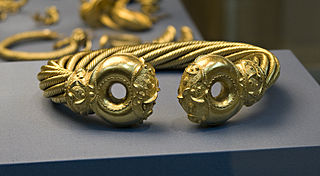 W
WThe Alfred Jewel is a piece of Anglo-Saxon goldsmithing work made of enamel and quartz enclosed in gold. It was discovered in 1693, in North Petherton, Somerset, England and is now one of the most popular exhibits at the Ashmolean Museum in Oxford. It has been dated to the late 9th century, in the reign of Alfred the Great and is inscribed "AELFRED MEC HEHT GEWYRCAN", meaning "Alfred ordered me made". The jewel was once attached to a rod, probably of wood, at its base. After decades of scholarly discussion, it is now "generally accepted" that the jewel's function was to be the handle for a pointer stick for following words when reading a book. It is an exceptional and unusual example of Anglo-Saxon jewellery.
 W
WThe Bülach fibula is a silver disk-type fibula with almandine inlay found in Bülach, Canton Zürich in 1927. The Alemannic grave in which it was found dates to the 6th century and contained the remains of an adult woman. The fibula, dated by most recent commentators to the latter half of the 6th or early 7th century, bears an Elder Futhark runic inscription, the only one found in Switzerland to date.
 W
WThe Great 'H' of Scotland was a jewel belonging to Mary, Queen of Scots. It was broken up in 1604 and made into the Mirror of Great Britain for James VI and I.
 W
WThe Great Torc from Snettisham or Snettisham Great Torc is a large, Iron Age electrum torc or neck-ring, the most spectacular object in the Snettisham Hoard of torcs and other metalwork found near the village of Snettisham in Norfolk, East Anglia. The perfectly intact torc is outstanding for its high level of craftsmanship and superb artistry. Soon after its discovery it was acquired by the British Museum.
 W
WThe Grumpan bracteate, designated as runic inscription Vg 207 by Rundata, is a gold type C bracteate found in Västergötland, Sweden in 1911. It is dated to the 6th century.
 W
WThe International Peace Belt is a living symbol of the peaceful unity of all nations.
 W
WThe Liudhard medalet is a gold Anglo-Saxon coin or small medal found some time before 1844 near St Martin's Church in Canterbury, England. It was part of the Canterbury-St Martin's hoard of six items. The coin, along with other items found with it, now resides in the World Museum Liverpool. Although some scholarly debate exists on whether or not all the items in the hoard were from the same grave, most historians who have studied the object conclude that they were buried together as a necklace in a 6th-century woman's grave. The coin is set in a mount so that it could be worn as jewellery, and has an inscription on the obverse or front surrounding a robed figure. The inscription refers to Liudhard, a bishop who accompanied Bertha to England when she married Æthelberht the king of Kent. The reverse side of the coin has a double-barred cross, or patriarchal cross, with more lettering.
 W
WSeeland-II-C is a Scandinavian bracteate from Zealand, Denmark, that has been dated to the Migration period. The bracteate bears an Elder Futhark inscription which reads as:hariuha haitika : farauisa : gibu auja : ttt
 W
WThe Sintra Collar is a Bronze Age gold neck-ring found near Sintra in Portugal. Since 1900, it has been part of the British Museum's collection and has long been admired for the sophistication and geometric beauty of its design and technique.
 W
WThe Tjurkö Bracteates, listed by Rundata as DR BR75 and DR BR76, are two bracteates found on Tjurkö, Eastern Hundred, Blekinge, Sweden, bearing Elder Futhark runic inscriptions in Proto-Norse.
 W
WThe Vadstena bracteate is a gold C-bracteate found in the earth at Vadstena, Sweden, in 1774. Along with the bracteate was a gold ring and a piece of gold sheet: all were nearly melted down by a goldsmith who was stopped by a local clergyman. The bracteate was stolen in 1938 from the Swedish Museum of National Antiquities and has not yet been found.